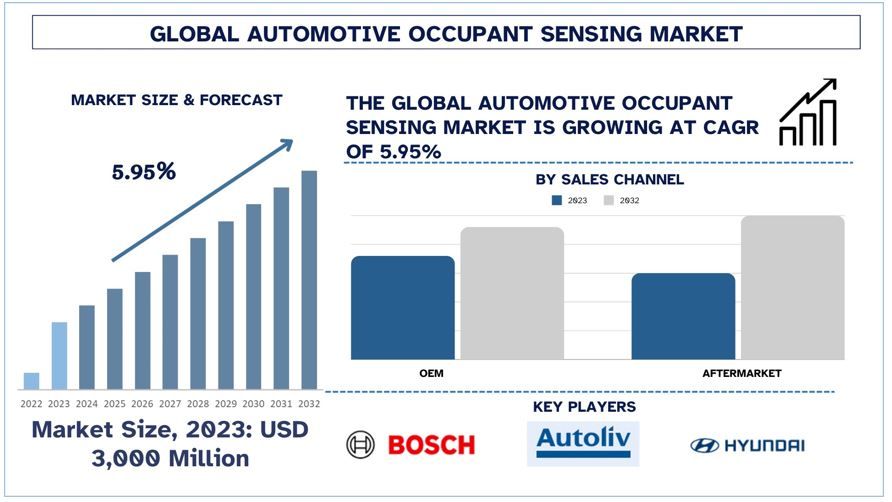
全球汽车乘员感知市场规模与预测
2023年,全球汽车乘员感知市场价值为30亿美元,预计在预测期内(2024-2032年)将以5.95%左右的强劲复合年增长率增长,这归因于全球对具有安全解决方案的汽车的需求不断增长。
全球汽车乘员感知市场分析
全球汽车乘员感知市场正在见证显著增长。汽车乘员感知系统包括各种传感器,如安全带张紧传感器、座椅下方的压力传感器、图像传感器、重量传感器等。这些传感器有助于车辆中的系统理解,从而提供额外的安全功能,如提供安全带警报、在发生碰撞时部署必要的安全气囊。此外,这些汽车乘员感知系统还在高级驾驶辅助系统的协调下,通过图像传感和超声波技术提供更好的乘客安全和保护。
2023年,全球汽车乘员感知市场价值为30亿美元,预计在预测期内(2024-2032年)将以5.95%左右的强劲复合年增长率增长。推动汽车乘员感知系统增长的因素之一是全球汽车销量的增长。随着新兴经济体收入的增长,客户正在寻求更安全的乘用车出行。根据国际汽车制造商组织(OICA)的数据,2020年汽车(包括乘用车和商用车)的总销量为7966万辆,2023年增至9272万辆。这大约是该时期总增长的16.3%。
此外,印度、中国、美国、印度尼西亚等国家的汽车销量在该时期均出现增长,考虑到安全性已成为汽车制造商和监管机构的关键因素之一,这对汽车乘员感知系统的增长是一个积极因素。
考虑到上述因素,预计未来几年汽车需求的积极增长将有利于集成到车辆中的安全解决方案。此外,可支配收入增加的客户将进一步关注提供强大安全系统的选项,从而进一步促进市场增长。因此,预计在2024-2032年期间,对汽车乘员感知系统的需求将呈现显着增长。
全球汽车乘员感知市场趋势
本节讨论了我们的研究专家团队确定的影响全球汽车乘员感知市场各个细分市场的关键市场趋势。
对基于ADAS的车辆的需求不断增长
随着对高级驾驶辅助系统(ADAS)的需求不断增长,对集成传感器的需求也在增长,这些传感器可以提高车辆的安全性和稳定性。ADAS可以在保持车辆在车道内行驶的同时辅助驾驶员,并在遇到任何障碍物时进行紧急制动。这些功能还需要车辆驾驶室内额外的安全功能,因为紧急制动需要收紧所有乘员的安全带。此外,由于新兴地区的车辆销量增加导致道路交通拥堵,因此集成ADAS和其他安全功能(如乘员感知系统)已变得至关重要。
此外,乘员感知系统是ADAS不可或缺的一部分,因为每个座椅中的传感器可以确定在发生事故时,需要根据车辆中乘客的数量部署哪些安全气囊。
考虑到全球对基于ADAS的车辆的需求不断增长,对汽车乘员感知系统的需求将在2023-2032年期间进一步增长。
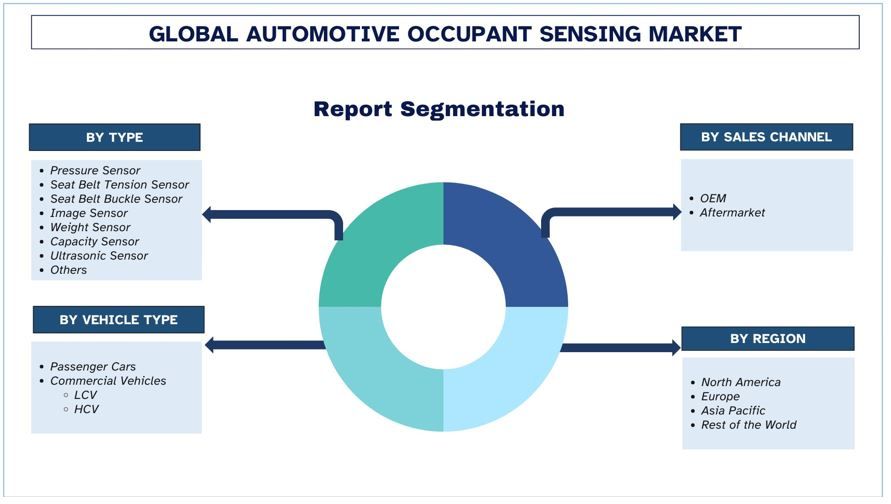
预计亚太地区在预测期内将占据主要市场份额
亚太地区的汽车乘员感知市场在2022年和2023年占据了相当大的市场份额。推动市场增长的一些关键因素是该地区汽车销量的增加。中国、印度、印度尼西亚、马来西亚、韩国、澳大利亚等新兴国家的中产阶级人口迅速增长。此外,这些地区还不断受到政府的推动,要求汽车制造商将安全系统集成到车辆中。此外,越来越多的公司专注于提高车辆的安全性和碰撞测试等级,也一直在大量投资于安全技术,其中汽车乘员感知系统是值得注意的。
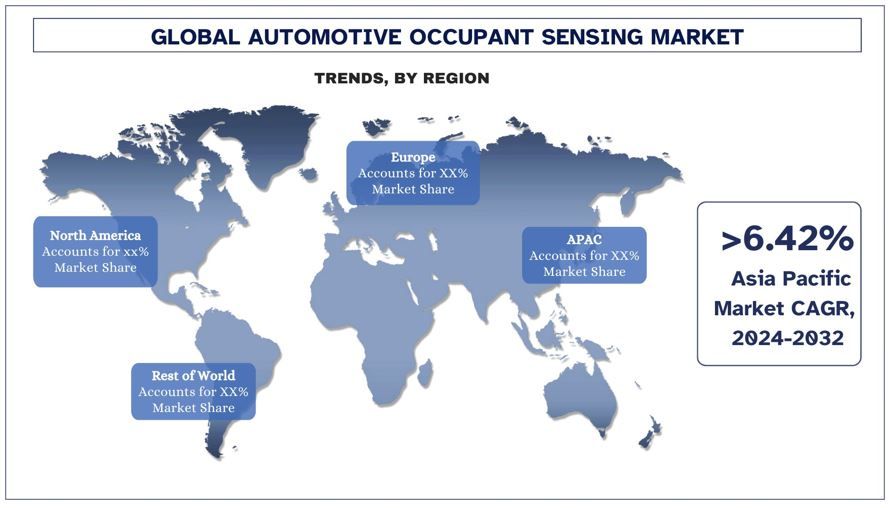
全球汽车乘员感知行业概览
全球汽车乘员感知市场竞争激烈且分散,存在多家全球和国际市场参与者。主要参与者正在采取不同的增长战略来增强其市场影响力,例如伙伴关系、协议、合作、新产品发布、地域扩张以及并购。在该市场运营的一些主要参与者包括Robert Bosch GmbH、Joyson Safety Systems、Autoliv Inc.、Continental AG、Hyundai Motor Company、Flexpoint、Denso Corporation、Valeo SA、ams-OSRAM AG和IEE Smart Sensing Solutions。
全球汽车乘员感知市场新闻
- 2024年,Novelda宣布推出用于乘客和儿童保护传感器的超宽带雷达传感器。
- 2024年,采埃孚被动安全系统公司宣布推出多级负载限制器(MSLL),该限制器可根据乘员的身材和尺寸调整安全带的约束力。
全球汽车乘员感知市场报告覆盖范围
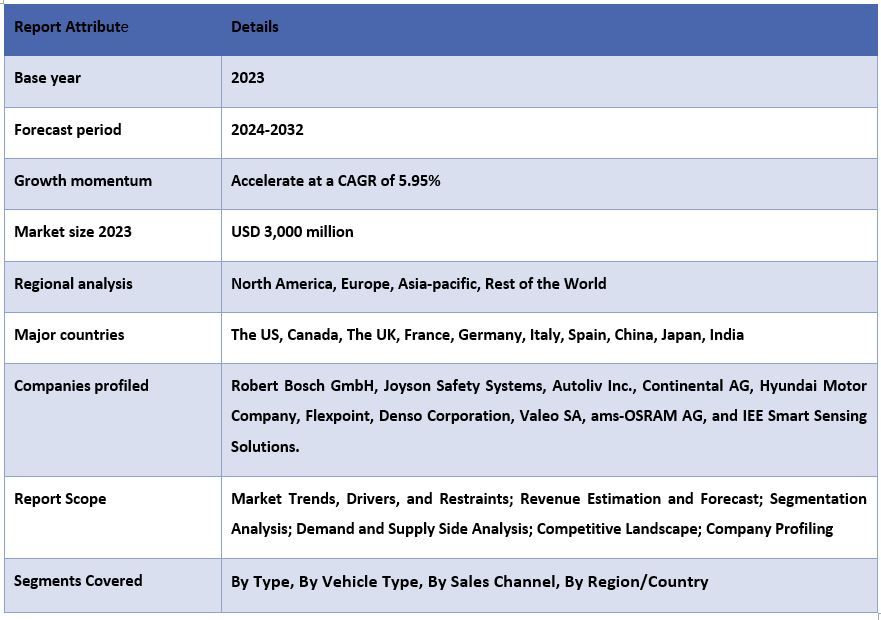
购买本报告的理由:
- 该研究包括由经过验证的关键行业专家验证的市场规模和预测分析。
- 该报告提供了一目了然的行业整体业绩的快速回顾。
- 该报告深入分析了杰出的行业同行,主要关注关键业务财务、产品组合、扩张战略和最新发展。
- 详细分析了行业中存在的驱动因素、制约因素、关键趋势和机遇。
- 该研究全面涵盖了不同细分市场的市场。
- 对该行业进行深入的区域层面分析。
定制选项:
全球汽车乘员感知市场可以根据需求或任何其他细分市场进一步定制。除此之外,UMI了解您可能有自己的业务需求;因此,请随时与我们联系以获取完全符合您需求的报告。
目录
全球汽车乘员感知市场分析的研究方法(2024-2032)
分析历史市场、估算当前市场以及预测全球汽车乘员感知市场的未来市场是创建和分析全球主要地区采用全球汽车乘员感知的三个主要步骤。进行了详尽的二次研究,以收集历史市场数据并估算当前的市场规模。其次,为了验证这些见解,考虑了许多发现和假设。此外,还与全球汽车乘员感知市场价值链中的行业专家进行了详尽的一手访谈。在通过一手访谈对市场数据进行假设和验证后,我们采用了自上而下/自下而上的方法来预测完整的市场规模。此后,采用了市场细分和数据三角测量方法来估算和分析行业细分市场和子细分市场的市场规模。下面解释了详细的方法:
历史市场规模分析
第1步:深入研究二手资料来源:
进行了详细的二手研究,以通过公司内部资料(如年度报告和财务报表、业绩演示文稿、新闻稿等)以及外部资料(包括期刊、新闻和文章、政府出版物、竞争对手出版物、行业报告、第三方数据库和其他可靠出版物)获得全球汽车乘员感知市场的历史市场规模。
第2步:市场细分:
在获得全球汽车乘员感知市场的历史市场规模后,我们进行了详细的二次分析,以收集主要地区不同细分市场和子细分市场的历史市场洞察力和份额。报告中包括主要细分市场,如按类型、按车辆类型和按销售渠道。此外,还进行了区域/国家级分析,以评估该地区测试模型的总体采用情况。
第3步:因素分析:
在获得不同细分市场和子细分市场的历史市场规模后,我们进行了详细的因素分析,以估算全球汽车乘员感知市场的当前市场规模。此外,我们使用因变量和自变量进行了因素分析,例如全球汽车乘员感知市场中的按类型、按车辆类型和按销售渠道。全面分析了供需情况,考虑了全球汽车乘员感知市场领域内的顶级合作伙伴关系、并购、业务扩张和产品发布。
当前市场规模估算与预测
当前市场规模测算:基于上述3个步骤中的可行见解,我们得出了当前的市场规模、全球汽车乘员感知市场中的主要参与者以及各细分市场的市场份额。所有必需的百分比份额拆分和市场细分均使用上述二手方法确定,并通过一手访谈进行验证。
估算与预测:对于市场估算和预测,为不同的因素分配了权重,包括驱动因素和趋势、限制因素以及利益相关者可用的机会。在分析了这些因素之后,应用了相关的预测技术,即自上而下/自下而上的方法,以得出2032年全球主要市场不同细分市场和子细分市场的市场预测。用于估算市场规模的研究方法包括:
- 就营收(美元)而言,行业市场规模以及全球汽车乘员传感市场在国内主要市场的采用率
- 市场细分和子细分的所有百分比份额、拆分和细分
- 全球汽车乘员传感市场中,在产品供应方面的主要参与者。此外,这些参与者为在快速增长的市场中竞争而采取的增长战略。
市场规模和份额验证
初步调研:与主要意见领袖 (KOL) 进行了深入访谈,其中包括来自主要地区的高管 (CXO/VP、销售主管、市场营销主管、运营主管、区域主管、国家主管等)。然后,对初步调查结果进行了总结,并进行了统计分析以证明所提出的假设。 初步研究的输入与次要调查结果合并,从而将信息转化为可操作的见解。
不同地区主要参与者的细分
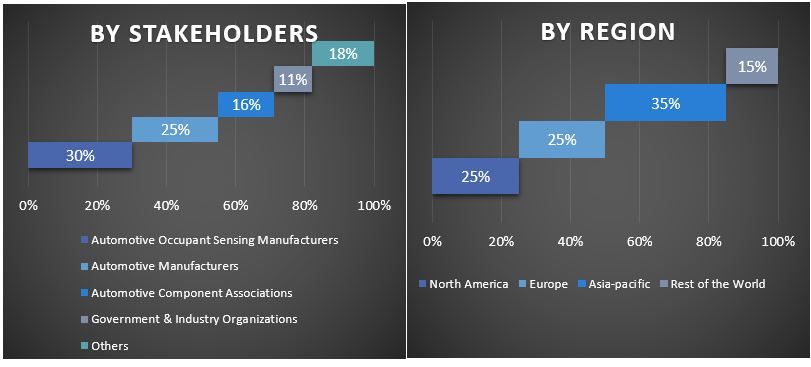
市场工程
采用数据三角测量技术来完成整体市场估算,并得出全球汽车乘员传感市场的每个细分市场和子细分市场的精确统计数字。在研究了各种参数和趋势后,按类型、按车辆类型和按销售渠道将数据拆分为几个细分市场和子细分市场。
全球汽车乘员传感市场研究的主要目标
在研究中指出了全球汽车乘员传感市场的当前和未来市场趋势。投资者可以获得战略见解,以根据研究中进行的定性和定量分析来确定其投资决策。 当前和未来的市场趋势决定了区域层面上市场的整体吸引力,为行业参与者提供了一个平台,以利用未开发的市场,从而受益于先发优势。 研究的其他定量目标包括:
- 按价值(美元)分析全球汽车乘员传感市场的当前和预测市场规模。此外,分析不同细分市场和子细分市场的当前和预测市场规模。
- 研究中的细分市场包括按类型、按车辆类型和按销售渠道划分的领域。
- 定义和分析全球汽车乘员传感行业的监管框架。
- 分析涉及各种中介机构的价值链,以及分析行业的客户和竞争对手行为。
- 分析全球汽车乘员传感市场主要地区的当前和预测市场规模。
- 报告中研究的主要国家/地区包括北美(美国、加拿大和北美其他地区)、欧洲(英国、法国、德国、意大利、西班牙、欧洲其他地区)、亚太地区(中国、日本、印度、亚太其他地区)、世界其他地区
- 全球汽车乘员传感市场的公司概况以及市场参与者为在快速增长的市场中生存而采取的增长战略。
- 对行业进行深度区域级分析
常见问题 常见问题
Q1: 全球汽车乘员传感市场的当前市场规模和增长潜力是什么?
Q2: 全球汽车乘员传感市场增长的驱动因素是什么?
Q3: 按类型划分,哪个细分市场在全球汽车乘员传感市场中占据最大份额?
Q4: 哪个地区将在全球汽车乘员传感市场中占据主导地位?
相关 报告
购买此商品的客户也购买了










